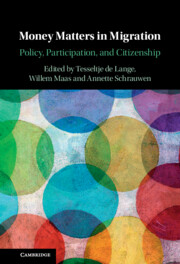1 - Money Matters in Migration: A Synthetic Approach
Published online by Cambridge University Press: 12 November 2021
Summary
This chapter introduces the reader to the book. It first describes the overall purpose of the book that brings together eighteen chapters that use money as a lens to address a wide range of cases from different disciplinary perspectives. Taken together its chapters balance empirical and theoretical work and use multiple methods. While the book does not force an overarching theoretical framework, it aims to facilitate overarching engagement and to encourage new multidisciplinary and interdisciplinary research into the role of money and resources on migration. Secondly, the chapter describes how aims, actors, and instruments are three important elements of analysis that return implicitly or explicitly in the individual chapters. It gives examples of how the lens of money can bring new insights to each of these elements in blurring formal distinctions. Thirdly, the chapter introduces the three parts of the book: migration, participation, and citizenship. It explains the choice for these three parts and how and why the distinct chapters connect under each part.
- Type
- Chapter
- Information
- Money Matters in MigrationPolicy, Participation, and Citizenship, pp. 1 - 16Publisher: Cambridge University PressPrint publication year: 2021



